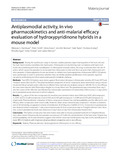| dc.contributor.author | Andayi, Andrew W | |
| dc.date.accessioned | 2016-09-28T16:43:21Z | |
| dc.date.available | 2016-09-28T16:43:21Z | |
| dc.date.issued | 2016 | |
| dc.identifier.uri | http://hdl.handle.net/123456789/113 | |
| dc.identifier.uri | https://www.ncbi.nlm.nih.gov/pmc/articles/PMC4681141/ | |
| dc.description.abstract | During the erythrocytic stage in humans, malaria parasites digest haemoglobin of the host cell, and
the toxic haem moiety crystallizes into haemozoin. Chloroquine acts by forming toxic complexes with haem molecules
and interfering with their crystallization. In chloroquine-resistant strains, the drug is excluded from the site of
action, which causes the parasites to accumulate less chloroquine in their acid food vacuoles than chloroquine-sensitive
parasites. 3-Hydroxylpyridin-4-ones are known to chelate iron; hydroxypyridone-chloroquine (HPO-CQ) hybrids
were synthesized in order to determine whether they can inhibit parasites proliferation in the parasitic digestive
vacuole by withholding iron from plasmodial parasite metabolic pathway. | en_US |
| dc.title | Antiplasmodial activity, in vivo pharmacokinetics and anti‑malarial efficacy evaluation of hydroxypyridinone hybrids in a mouse model | en_US |

